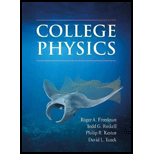
Cylinder's speed at the bottom of the ramp.
Answer to Problem 67QAP
Explanation of Solution
Given info:
Uniform solid cylinder of,
Radius
Mass
An inclined plane,
Length
Angle which tilted with horizontal plane
Cylinder rolls without slipping down the ramp.
Formula used:
Let's name the vertical height of the plane as
Let's name the angular velocity of cylinder at the bottom of the ramp as
Let's name the linear speed of cylinder at the bottom of the ramp as
Let's name the moment of inertia of cylinder as
Conservation of mechanical energy:
Kinetic energy for an object that undergoes both translation and rotation:
Condition for rolling without slipping:
Calculation:
Let's consider the motion of cylinder,
Initially the cylinder is at rest with zero kinetic energy, so
The initial gravitational potential energy is
Final gravitational potential energy is
Conservation of mechanical energy:
But, according to the data given,
So,
Let's consider the kinetic energy
Kinetic energy is part translational and part rotational. We can use
In terms of
Using
Kinetic energy for an object that undergoes both translation and rotation:
Condition for rolling without slipping:
Substitute into kinetic energy equation:
From the general knowledge we know that moment of inertia of a cylinder is
So, let's substitute the
Since
Let's substitute the values,
Conclusion:
Thus, cylinder's speed at the bottom of the ramp is
Want to see more full solutions like this?
Chapter 8 Solutions
COLLEGE PHYSICS
 College PhysicsPhysicsISBN:9781938168000Author:Paul Peter Urone, Roger HinrichsPublisher:OpenStax College
College PhysicsPhysicsISBN:9781938168000Author:Paul Peter Urone, Roger HinrichsPublisher:OpenStax College Physics for Scientists and Engineers, Technology ...PhysicsISBN:9781305116399Author:Raymond A. Serway, John W. JewettPublisher:Cengage Learning
Physics for Scientists and Engineers, Technology ...PhysicsISBN:9781305116399Author:Raymond A. Serway, John W. JewettPublisher:Cengage Learning Principles of Physics: A Calculus-Based TextPhysicsISBN:9781133104261Author:Raymond A. Serway, John W. JewettPublisher:Cengage Learning
Principles of Physics: A Calculus-Based TextPhysicsISBN:9781133104261Author:Raymond A. Serway, John W. JewettPublisher:Cengage Learning College PhysicsPhysicsISBN:9781285737027Author:Raymond A. Serway, Chris VuillePublisher:Cengage Learning
College PhysicsPhysicsISBN:9781285737027Author:Raymond A. Serway, Chris VuillePublisher:Cengage Learning University Physics Volume 1PhysicsISBN:9781938168277Author:William Moebs, Samuel J. Ling, Jeff SannyPublisher:OpenStax - Rice University
University Physics Volume 1PhysicsISBN:9781938168277Author:William Moebs, Samuel J. Ling, Jeff SannyPublisher:OpenStax - Rice University College PhysicsPhysicsISBN:9781305952300Author:Raymond A. Serway, Chris VuillePublisher:Cengage Learning
College PhysicsPhysicsISBN:9781305952300Author:Raymond A. Serway, Chris VuillePublisher:Cengage Learning





